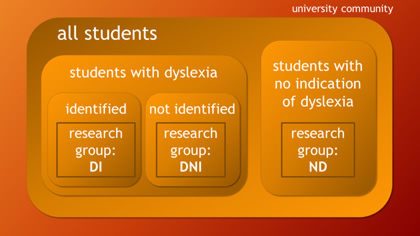
project outline | design | post-project
discourse study-blog | resources | lit review maps | profiles
enquiry research QNR | dysdefs QNR | dysdims QNR
thesis overview | literature | research design | data & analysis | discussion | conclusions
discourse study-blog | resources | lit review maps | profiles
enquiry research QNR | dysdefs QNR | dysdims QNR
thesis overview | literature | research design | data & analysis | discussion | conclusions
 research design
research design
Research design strategy
The principal research objective is to determine if there is evidence that students who exhibit characteristics of dyslexia but who are otherwise not identified as dyslexic present a significantly different academic (behavioural) confidence (ABC) level in comparison to a group of peers who are known to have a dyslexic learning difference, with both groups' ABC measured against a control group of peers who exhibit no indications of dyslexia as part of their learning profile.
 These three research groups are to be referred to as:
These three research groups are to be referred to as:
The principal research objective is to determine if there is evidence that students who exhibit characteristics of dyslexia but who are otherwise not identified as dyslexic present a significantly different academic (behavioural) confidence (ABC) level in comparison to a group of peers who are known to have a dyslexic learning difference, with both groups' ABC measured against a control group of peers who exhibit no indications of dyslexia as part of their learning profile.
 These three research groups are to be referred to as:
These three research groups are to be referred to as:
- Research group ND: students with no indication of dyslexia;
- Research group DI: students with a dyslexic learning difference that has already been identified;
- Research group DNI: students with a dyslexic learning difference that has NOT previously been identified;
- Part I
The first part of the research focuses on the Profile Charts
The rationale for the profiles is a legacy of the pilot study because it is realized that a great deal of information is locked up in these collective, graphical representations of feelings and attitudes towards study at university when this is quanitified in terms of the five sub-constructs of self-esteem, self-efficacy, learned helplessness, anxiety, regulation and motivation, and learning-related emotions (affective process).
In the pilot study, the profiles established are exclusively those of students with a dyslexic learning difference so it is imperative that the profiles are robustly explored and developed in this PhD project so that they can be confidently used as an indicator of the liklihood of dyslexia being part of students' learning persona. This is because it will be on the strength of the profiles as a discriminator that research group DNI will be established.
The idea is that by collecting data from students with identified dyslexia and using this to create a portfolio of profiles, these can be compared to profiles created from data collected from students who, as far as is known, do not have dyslexia. It is expected that significant differences between these two portfolios of profiles will emerge, hence enabling this idea of profiling to be a identifier of dyslexia in HE student communities.
Subsequently the data gathering tool, most likely an e-Questionnaire, can be redeployed across a much larger cohort of students in the university community in order to find students who have profiles aligned with those generated by the dyslexic group (DI) - hence showing an indication of dyslexia - but who have not had dyslexia previously identified. This will enable the research group DNI to be established. - Part II
lt is in the second part of the project that levels of Academic (Behavioural) Confidence are explored.
Having used the profiles to establish research group DNI, research group ND can also be established through data collected from this wider university community of students. Lastly, from the university's student group whose existing dyslexic learning difference is already known, either through disclosure prior to admission to their courses or who have had their dyslexia identified at some point whilst studying at the university, the third research group DI can be established.
Students within each group will complete an assessment of their Academic (Behavioural) Confidence using the standardized evaluators developed by Sander & Sanders (2006) which will be statistically analysed to look for significant differences between the groups that can relate to the research questions and hypotheses. - Discussion and write-up
The final stage of the project will be to write up the results of the analysis, relate these to the existing literature and condense the project into a thesis for assessment of the award of PhD. It is intended that publication of the complete project will be the concluding development of these webpages and constitute and e-Publication of the research to the wider academic community.
The Journal section of these webpages is the discussion area and 'writing pad' for the complete project, where the continuous literature review is located in the form of a Study Blog and innovative Literature Review Maps, and where, as the project progresses, the working data analysis will be available.